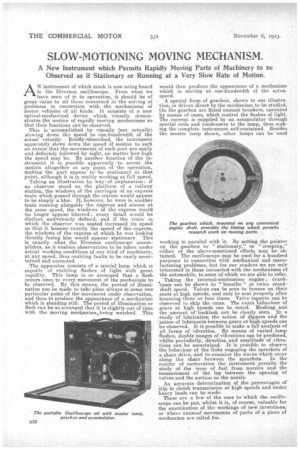SLOW-MOTIONING MOVING MECHANISM.
Page 14

If you've noticed an error in this article please click here to report it so we can fix it.
A New Instrument which Permits Rapidly Moving Parts of Machinery to ne Observed as if Stationary or Running at a Very Slow Rate of Motion.
AN instrument of which much is now being heard is the Elverson oscilloscope. From what we . have seen of it in operation, it should be of great value to all those concerned in the solving of problems in connection with the mechanisms of motor vehicles of all kinds, it consists of a new optical-mechanical device which visually demonstrates the motion of rapidly moving mechanisms so that their functions can be observed.
This is ' accomplished by visually (not actually) slowing down the speed to one-hundredth of the actual velocity. Briefly-described, the instrument apparently slows down the speed of motion to such an extent that the movements of each part are easily and definitely followed by sight., no matter how high the speed may be. By another function of the instrument it is possible apparently • to arrest the motion altogether at any point of the operation, making the part appear to be stationary at that point, although it is in reality working at full speed. Taking an illustration by way. of explanation : if an observer stood on the platform of a railway station, the windows of the carriages of an express train which passed through the station would appear to be simply a blur. If, hoWever, he were in another train running alongside the express and almost at the same speed, the windows of the express would no longer appear. blurred ; every detail would be distinct antheclearly defined, and if the train in which the observer was seated increased its speed so that it became exactly the speed of the.express, the windows of the express at which he was looking directly facing him would appear stationary. This is exactly what the Elverson oscilloscope accomplishes, as it enables observations to be taken under actual working conditions of any kind of machinery, at any speed, thus enabling faults to be easily ascertained and corrected. •
The apparatus consists of a special lamp which is capable of emitting flashes of light with great rapidity. This lamp is so Arranged that a flash occurs once to every movement of the mechanism to be observed. By this means, the period of illumination can be made to take place always at Aome one particular point of the movement under observation, and thus to produce the appearance of a mechanism which is standing still. The period of illumination or flash can be so arranged that it is slightly out of time with the moving mechanisin.,,being watched. Thia
would then produce the appearance of a mechanism which is moving at one-hundredth of the actua. speed.
A epecial form of gearbox, shown in our illustration, is driven direct by the mechanism to be studied. On the gearbox are fitted contact breakers, operated b means of cams, which control the flashes of light. The current is supplied by an accumulator through special coils and condensers to the lamp, thus making the complete instrument self-contained. Besides the master lamp shown, other lamps can be used
working in parallel with it. By setting the pointer on the gearbox to "stationary," or "creeping," either of the above-mentioned effects may be obtained. The oscilloscope may be used for a hundred purposes in connection with mechanical and manufacturing problems, but for our readers we are only interested in those connected with the mechanisms of the automobile, to some of which we are able to refer. ' Taking the internal-combustion engine ; crankcases can be shown to " breathe " at twice crankshaft speed. Valves can be seen to bounce on their seats at high speeds, and only to seat properly after bouncing three or four times. Valve tappets can be observed to skip the cams. The exact behaviour of gears at high speeds can be noted. Meshing and the amount of backlash can be clearly seen. In a ,study of lubrication the action of dippers and the action of lubricants between gears at high speeds can be observed. It is possible to make a full analysis of all forms of vibration. By means of varied lamp flashes, double images of vibrations can be produced, whilst periodicity, direction and amplitude of vibrations can be ascertained. It is possible to observe the behaviiour of the links engaging the sprockets of a chain drive, and to examine the waves which occur along the chain between the sprockets. In the matter of carburation the instrument permits the study of the issue of fuel from nozzles and the measurement of the lag between the opening of valves and the suction on the nozzle.
An accurate determination of the percentages of 'slip in clutch transmission at high speeds and under heavy loads can be made. These are a few of the uses to which the oscilloscope can be put, whilst it is, of course, valuable for the examination of the workings of new inventions, or where unusual movements of parts of a piece of mechanism are called for.
































